In June we started a batch of umeboshi, remember? We got a pile of ume, cleaned them and pickled them, some plain and some with shiso leaves which give them a distinctive taste and an intense red color. We're making four kinds in all: plain, honey-flavoured (not sure about that one), a bit of shiso, and lots of shiso.
After a couple of months of pickling, it's time to dry them in the sun. "Umeboshi" (梅干し) literally means "dried ume" so not drying them would of course be a bit weird - what'd you call them for a start? "umeboshijanai" (梅干しじゃない - "It's not dried ume")? "umewaritonureteiru" (梅割と濡れている - "Comparatively wet ume")? Anyway, we dried them during the o-bon holidays. That's the traditional time to do it as tsuyu is normally over by then; also, they need about three days to dry and it can be hard to organize if you're working at the same time.
The ume has gone all soft, plump and squishy from being pickled. Some people like to eat them like this, but the drying process makes them firmer and chewier, and gives them a more intense flavour.
Early in the morning, you place the ume on a big, sieve-like bamboo frame, not too close together. Be careful; they're really soft. Place the frame in the sun (we use our balcony). Around midday, rotate the ume - one by one - so they don't stick to the frame and so they get to dry from all sides. In the evening you rotate them again, then you take the frame inside overnight.
Note that you don't actually need full sun all the time, just dry, clear and hot weather. Our balcony is in shadow for half the day and it doesn't seem to affect the process at all. This is the sieve with the four different kinds of ume we're making.
After three days of drying, they'll start looking all scrunched up and shriveled and feel fairly firm to the touch - though it depends on the kind of ume you're using, and the kind you're making too; note how different they are from each other.
Here's the same type of ume (the "lots of shiso" one) before and after drying. Once they're done, you return them into the brine jars. You're supposed to be able to eat them almost directly after, but it's probably a good idea to let them be for a week or so at least, so they get to soak up a bit of liquid and stabilize.
Once done they'll be good for at least a year. The only risk is getting mold on the surface, apparently, but we've never gotten that so far. We're on our final jar of last year's umeboshi right now and they taste great; if anything the flavour keeps developing over time, making them intensely savoury by now.

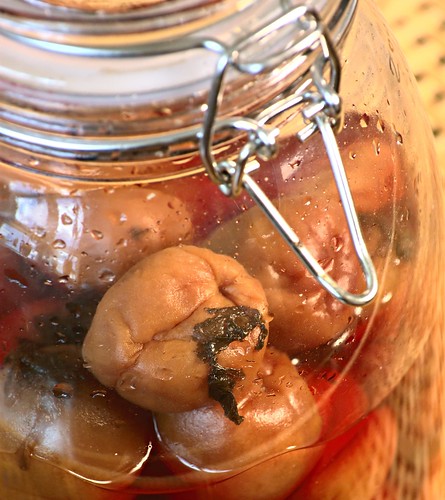
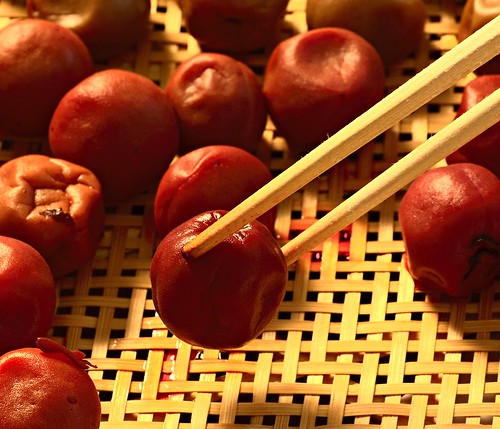
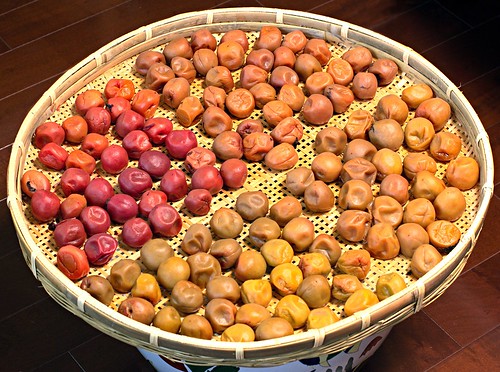
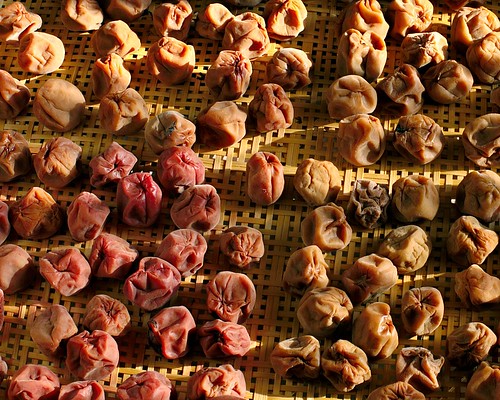
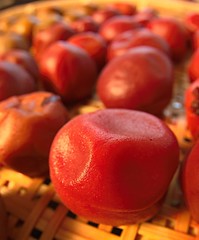
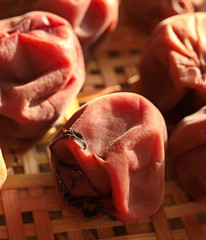
Hi there. Just wondering how is the weather in Osaka like? I am touching down this Sunday but I haven't packed yet. Haven't got the faintest idea about what to pack? Is it hot and humid still? Windy? Occassional rain? Could you please let me know? Tq in advance :D
ReplyDeleteThose images of umeboshis always induces secretion of saliva and desire for rice. I sometimes wonder what happens to those people who had never tasted any umeboshi.
ReplyDeleteWeather is unsteady but cooler - about 30° or so. The fall seems to be right around the corner.
ReplyDeleteUme is a favourite food, yes. Lots of ways you can use them too. We make Ume udon sometimes, and I like mashing them up with soy sauce and use as a dip for gyouza or on tofu.
Thanks Janne. That means I gotta pack heavier .. huhuuhuu. Hope to be able to try umeboshis there :D
ReplyDeleteOff the topic, how come you come and stay in Japan as a researcher?
ReplyDeleteIs it because there are some advantages for foreign scientists to work there?
After you get a doctorate, your next position is a so-called "post-doc" which you're expected to to at a different university. The purpose is to gain experience from other labs, expand your network of contacts and get used to working on your own. And often you will go not just to a different university but to a different country - though that seems less common in large countries like Japan or the USA where you have a large number of places to choose from nationally. A post-doc in a different country is often an extra bonus when you look for a job.
ReplyDeleteSo in my case I went to Japan. There's plenty of interesting work in my field here, but truth be told, the same could be said for USA, Germany, Canada, Italy, Korea and a number of other countries too. I ended up in Japan because my advisor happened to know a couple of people here already, and because I was able to get funding for it (JSPS - the Japanese Society for Promotion of Science - has a very good, well regarded program for funding foreign post-docs).
As to why I stay, that really has little to do with research and much to do with my family life. I could work in any country, but my wife is from Osaka and most of her relatives and friends are here. And as we both like Osaka very much this is where we choose to live.
Well, after you finish your post-doc here, do you plan to return to Sweden or relocate to another country?
ReplyDeleteI finished my post-doc years ago. I've on my third research job after my initial post-doc here already. And no, we're not moving anywhere. We stay in Osaka, and I find work here. I've been able to stay in research so far, but we'll see how long I can continue.
ReplyDeleteWow, you made umeboshi! I have made umeshu with the pros but no umeboshi yet.
ReplyDeletehttp://kyotofoodie.com/umeshu-learning-to-make-umeshu-in-fushimi-kyoto-part-1/
http://kyotofoodie.com/umeshu-learning-to-make-umeshu-in-fushimi-kyoto-part-2/
Next year I think you should try kombu ume(boshi), that is my fav I think. Honey is nice too. And how about katsuobushi ume(boshi), that goes nice in onigiri.